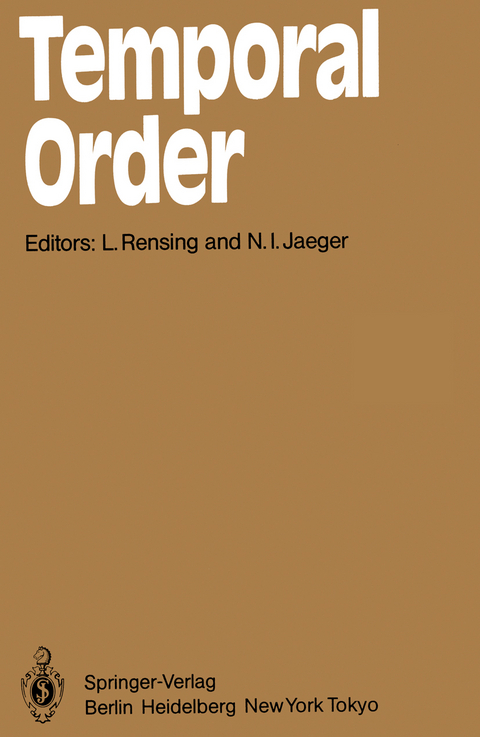
Temporal Order
Springer Berlin (Verlag)
978-3-642-70334-8 (ISBN)
I Dynamics of Chemical Systems.- Spontaneous Temporal and Spatial Phenomena in Physicochemical Systems.- Some Factors Generating Temporally Ordered Behavior.- Mechanisms and Chemically Consistent Models for Isothermal Oscillations in the CSTR.- Analysis and Qualitative Modelling of Experimentally Observed Dynamic Features.- A Physicist's Description of Chemical Oscillations.- Multiplicity-Induced Oscillations in Porous Catalysts.- Temporal Oscillations Induced by Boundary Conditions in Systems with and Without Spatial Patterns.- On the Classification of Local Disorder in Globally Regular Spatial Patterns.- Some Proposals Concerning the Mathematical Modelling of Oscillating Heterogeneous Catalytic Reactions on Metal Surfaces.- In-Situ IR Study During Oscillations of the Catalytic CO Oxidation.- Spatial Effects and Oscillations in Heterogeneous Catalytic Reactions.- Dynamics of the Heterogeneous Catalytic Oxidation of Carbon Monoxide on Zeolite Supported Palladium.- Toroidal Oscillations During the Oxidation of Methanol on Zeolite Supported Palladium.- Oscillatory Behavior of Cobalt Electrodes During Transition from the Active to the Passive State.- Periodic and Aperiodic Regimes in Forced Chemical Oscillations.- Periodic Perturbation of the BZ-Reaction in a CSTR: Chemical Resonance, Entrainment and Quasi-Periodic Behavior.- Periodic Perturbation of Limit Cycles in an Isothermal CSTR.- Oscillations in a CSTR Affected by the Pump Periodicity.- II Dynamics of Biological Systems.- Synchronization, Phase-Locking and Other Phenomena in Coupled Cells.- The Influence of Fluctuations on Sustained Oscillations.- Movement in Space.- Chemomechanical Interfacial Instabilities and Waves: Their Possible Role for the Cell Locomotion on Substrates.- Contraction and Oscillations in aSimple Model for Cell Plasma Motion.- Circle Maps and the Periodic Forcing of Limit Cycle Oscillators.- Cellular Metabolism and Transport.- Dynamic Coupling and Time Patterns in Biochemical Processes.- Dimension and Liapunov Exponents of a Strange Attractor from Biochemical Data.- Coupling of Glycolytic Oscillations and Convective Patterns.- Computation of Bifurcation Diagrams for Selkov's Model of Glycolytic Oscillations.- Comparison of the Linear and Non-Linear Temperature Properties and Model Simulations of the In Vivo Glycolytic System.- Circadian Rhythms.- High Molecular Weight Protein is Presumably Essential for the Circadian Clock.- Circadian Time-Dependent Effects of Plant Growth Regulators on Morphogenesis in Acetabulavia.- Phase and Period Effects of Physical and Chemical Factors. Do Cells Communicate?.- Singularity in a Unicell: Can Pulses of Protein Synthesis Inhibitors Stop the Biological Clock?.- Circadian Control of Protein Synthesis Rate in Cell-Free Extracts of Gonyaulax polyedra.- Perturbation by Single and Double Pulses as Analytical Tool for Analyzing Oscillatory Mechanisms.- Effects of Light and Temperature Steps on Circadian Rhythms of Neurospora and Gonyaulax.- Genetic and Physiological Analysis of a Circadian Clock Gene in Neurospora crassa.- Cyclic Activity of Enzymes of Asparagine-Pyruvate Pathway and Cellular Synchronization. Significance of L-Asparaginase Oscillatory States.- Control and Significance of the Circadian Growth of the Endocuticle in Cockroaches (Blaberus craniifer, Blattodea).- The Hypothalamic Control of Eating and Circadian Rhythms: Opponent Processes and Their Chemical Modulators.- The Circadian Activity Rhythm of Mammals: A Comparison of Models and Experiments.- Weak Coupling Between the Two Pacemakers of the BilateralCircadian Mechanism in Crickets.- Effect of Reversed Photoperiod on Daily Rhythms of Synthesis and Accumulation of Neurosecretion in the Brain of the House Cricket.- Circadian Rhythm of Locomotor Activity in Musca Continues After Severance of Optic Tracts.- Interaction Between Two Circadian Clocks in the Rabbit and Their Main Input.- Cell Cycle.- Dynamics of Feedback Systems with Time Lag.- The Coordination of Cell Growth and Division: A Comparison of Models.- Cellular Synergetics: Cell-Density Dependent Regulation of Population Dynamics of Mammalian Cells in Vitro.- Idiotypic Network Among T Cells.- The Transition Probability Model: Successes, Limitations, and Deficiencies.- A Deterministic Cell Cycle Model with Transition Probability-Like Behaviour.- The Onset of Division in a Protocell Model.- A Temperature Compensated Epi genetic Oscillator with an Hourly Period Provides Time-Keeping for the Cell Cycle and Possibly also for Circadian-Controlled Phenomena.- Index of Contributors.
| Erscheint lt. Verlag | 17.11.2011 |
|---|---|
| Reihe/Serie | Springer Series in Synergetics |
| Zusatzinfo | X, 328 p. |
| Verlagsort | Berlin |
| Sprache | englisch |
| Maße | 170 x 244 mm |
| Gewicht | 594 g |
| Themenwelt | Naturwissenschaften ► Chemie ► Physikalische Chemie |
| Naturwissenschaften ► Physik / Astronomie ► Allgemeines / Lexika | |
| Naturwissenschaften ► Physik / Astronomie ► Theoretische Physik | |
| Schlagworte | Bifurcation • biological • catalyst • Chaos • Environment • Equilibrium • Experiment • Fields • Influence • metals • Non-Equilibrium Systems • Oscillation • stability • Structure • Synergetics |
| ISBN-10 | 3-642-70334-8 / 3642703348 |
| ISBN-13 | 978-3-642-70334-8 / 9783642703348 |
| Zustand | Neuware |
| Haben Sie eine Frage zum Produkt? |
aus dem Bereich


